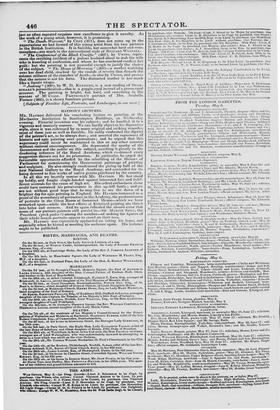HAYDON'S LECTURES.
MR. HAYDON delivered his concluding lecture on painting, at the Mechanics Institution in Southampton Buildings, on Wednesday evening. Pictorial invention was his subject ; and he handled it in a vigorous and masterly manner. We can hardly object to his digressive style, since it was redeemed by so many original and striking remarks, most of them just as well as forcible. He nobly vindicated the dignity of the painter's art, as he always does ; and asserted the supremacy of historic and epic painting over portraiture; and he argued that this supremacy.could never be maintained in this or any other country without national encouragement. He deprecated the apathy of the Government and the public on this subject, ascribing it greatly to the deadening influence of the Royal Academy, which cushioned every suggestion thrown out for its promotion. In particular, he urged the favourable opportunity afforded by the rebuilding of the Houses of Parliament for commencing the Government patronage of painting and sculpture. He also strongly condemned the giving up half of the new National Gallery to the Royal Academy, and contended for its being devoted to fine works of native genius purchased by the country. In all this we heartily concur with Mr. HAYDON. He has stood sip boldly, and fought single-handed against interested foes and indif- ferent neutrals for the cause of high art. His ardent enthusiasm alone could have sustained his perseverance in this up-hill battle ; and we are not without good hope that he may live to see the dawn of a brighter day for epic painting in England. Mr. HAYDON instanced as a proof of the ascendancy of portraiture in the Academy, the predominance of portraits in the Great Room at Somerset House—which we have remarked upon—while the best efforts at historical painting are thrust into holes and corners. And he again ridiculed the absurd error that some of our portrait-painters still persist in—Sir MARTIN SHEE, the President (proh pudor 1) among the number—of making the figures of their whole-length portraits appear to stand on their toes.
Mr. HAYDON was rapturously applauded on taking his leave, and especially when he hinted at meeting his audience again. his lectures ought to be published.


























 Previous page
Previous page